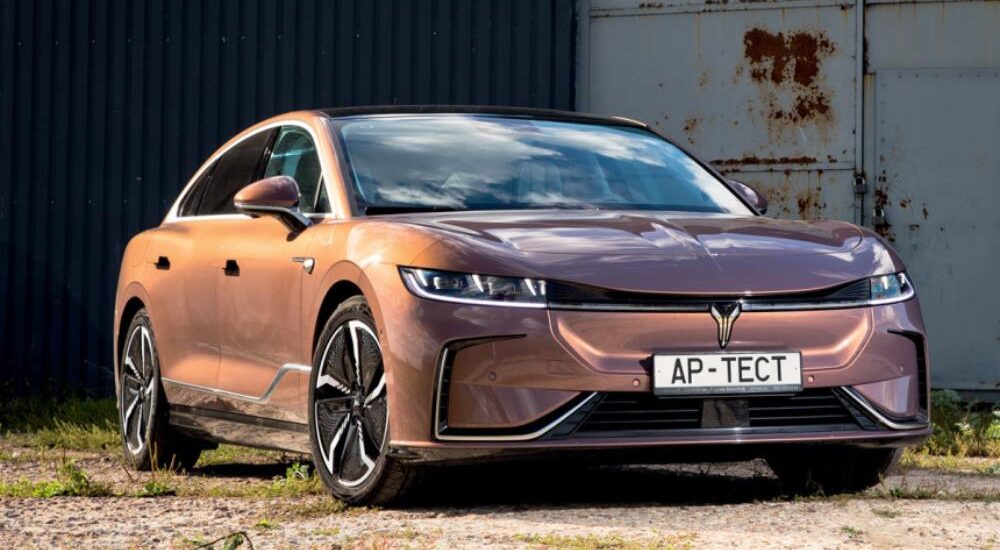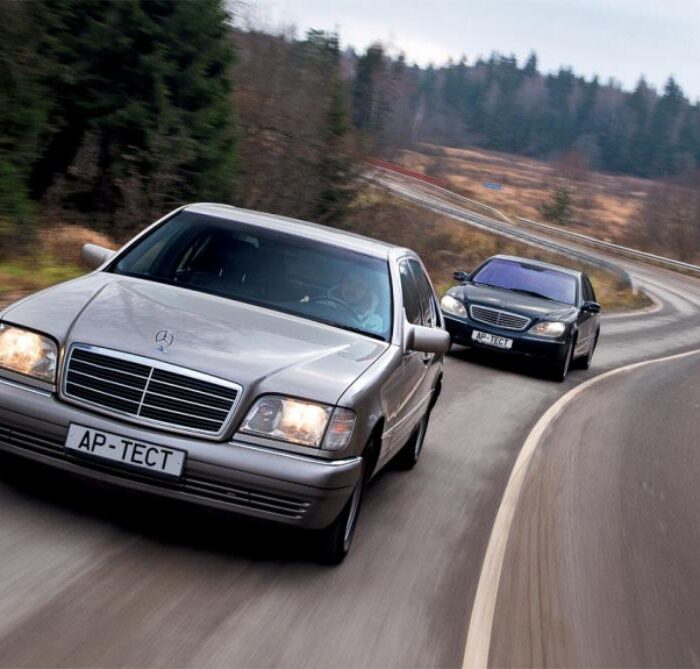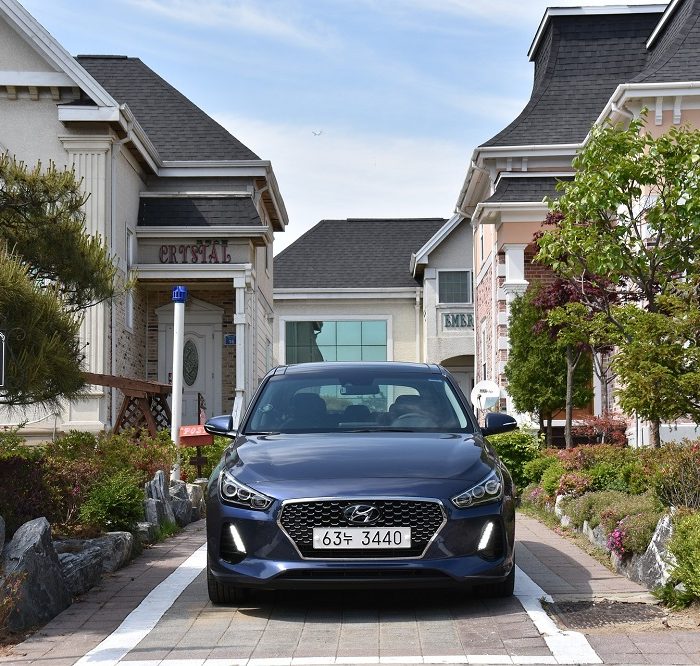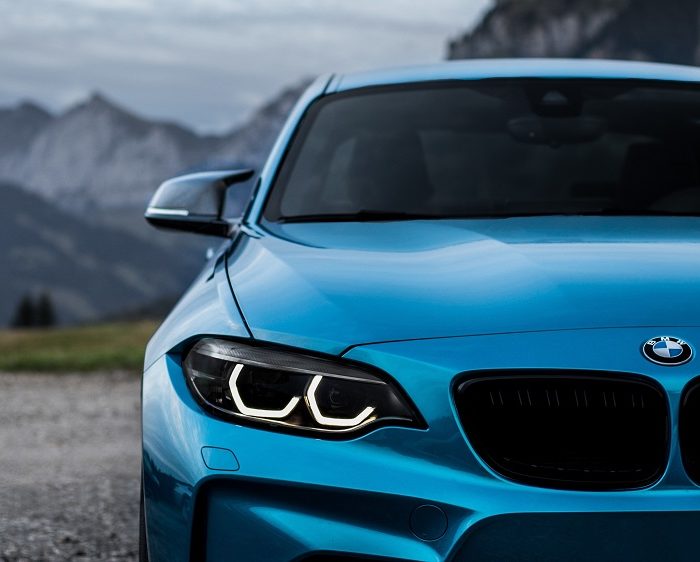I twirl the oval transponder key in my hand, wondering if it’s the second key, possibly the service key? It’s lightweight, plastic, with inconvenient buttons on the edges that can be tricky to press. However, as I find myself inside the cabin, my initial annoyance turns into sheer delight. Ahead of me lies the dynamometer track at the proving ground, where the Voyah Passion is set to truly reveal its passion!
Voyah, the Chinese brand created three years ago by the Dongfeng conglomerate, is steadily making its mark on the Russian market with its new line of electrified vehicles. By the end of summer 2023, the Voyah Free crossover and the Voyah Dreamer minivan had become the most popular electric vehicles in Russia, with 1989 units sold in just eight months. While the demand is much higher in their home country, China (20 thousand units), Russia stands as one of the top export markets, with only 118 Voyah cars sold in Israel and roughly the same number in Norway. Sales have just begun in Turkey, indicating that the Russian market is a priority for the Chinese brand, even in terms of adaptation and Russification.
The sedan marks Voyah’s third model. In its homeland, it goes by the name 追光, which translates from Chinese as “chasing the light.” While it sounds romantic, the pronunciation, “zhui guang,” may not be quite the customer magnet. Fortunately, for international deliveries, the car has been named Voyah Passion. True to its name in English, the design of this car is indeed a passion project. Renowned artists from the Italdesign studio contributed to crafting its image. Smooth lines define the body, which, in terms of proportions, resembles a liftback, although it’s technically a sedan.

When it comes to details, the craftsmanship is precise, evident even in the panel gaps. The stunning bronze paintwork creates a chameleon effect in the sunlight. There’s no need to delve into the lighting technology, as even budget Chinese cars today boast advanced optics. The Passion is no exception, featuring illuminated logos, LED strips stretching from ear to ear, and dynamic turn signals. Through the menu, you can select one of three LED greeting scenarios when unlocking the car. However, curiously, there are no keyless entry sensors on the retractable door handles—an omission on a car with an 8.5 million ruble price tag.
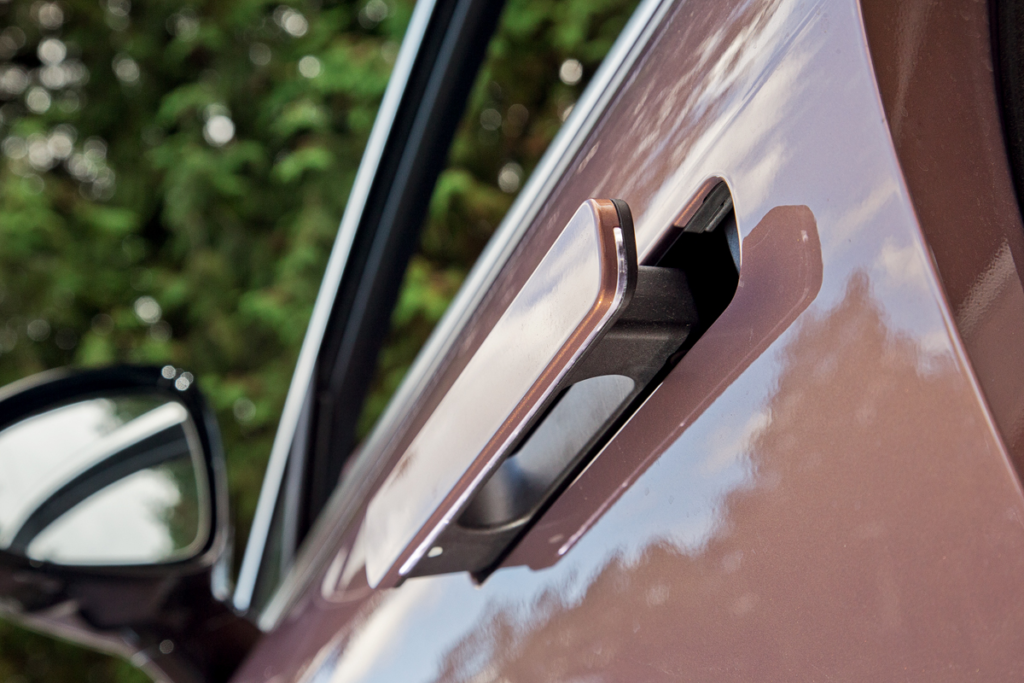
Retractable door handles – with built-in lighting
Inside, aesthetics take center stage. In addition to plastic, the cabin incorporates eco-leather, alcantara, and aluminum trim. There are two sunshades overhead that open up to reveal the extensive panoramic roof, with its glass extending to the rear headrests. Thanks to these finishing touches and the generous glass area, the cabin feels bright even on overcast days.

On the front panel, there are four screens at once. The right elbow often accidentally presses the ‘crystal’ button to open the central box.

The menu includes comprehensive cabin settings. For example, the Baby Care mode involves closing the windows and the ceiling curtain, reducing the audio system volume, and displaying a view of the rear seats on the central screen.

The cabin camera allows you to observe children on the rear seats – and even record videos of their ‘performances.’

You can display images from different cameras on the central screen or activate the ‘transparent chassis’ mode.
However, your attention is bound to be drawn to the multifaceted steering wheel. It’s not flattened at the bottom or squeezed from both sides but genuinely faceted, composed of a series of slightly curved chords. The steering wheel feels quite different from the speedy steering that the unforgettable Ernest Sergeyevich Tsygankov taught; here, the steering wheel literally dances in your hands when turned from lock to lock (which is the standard 2.7 turns)! Thankfully, the classic grip “without fifteen three” is comfortable for holding onto the rim.

Faceted steering wheel – not for fast rotation with interceptions
As for touch controls for everything, even students of Tsygankov’s teachings will be puzzled. The climate control is managed via a tablet, while opening the sunshades on the ceiling is handled by sensors. Even the power window buttons use tactile controls, requiring confident presses; gentle touches yield no response. Over time, of course, you get used to it and adapt, but traditional physical buttons are often more convenient. In Europe, Volkswagen, for example, after experimenting with steering wheel-mounted sensors, is returning to physical buttons. The Voyah Passion, on the other hand, is touch-sensitive to its core, down to its Qualcomm Snapdragon 8155 chip, which serves as the foundation for its operating system.

To partially open or close any of the four windows, you need to hold your finger on the touch button, while a short touch is sufficient for full opening or closing.
The abundance of settings may seem overwhelming at first. Some are accessible via the central display, while others are found on the lower tablet, which also controls the four-zone climate system. You’ll also need to search for the seat heating and ventilation controls, as well as the massage program activation, which is also available to rear passengers. However, by the end of the third day, I had become quite familiar with the menu; the main challenge is to avoid direct sunlight on the screen. In bright sunlight, inscriptions and symbols become hard to discern. It’s worth noting that all the menus are currently in English, but a Russian firmware update is expected in November, similar to the one available for the Dreamer minivans and Free crossovers sold today.

The transmission mode selection dial does not bother you with delays
The transmission mode selector knob doesn’t cause any delays, but even after the Russification, Passion won’t fully reveal itself to you. After all, most of its services are designed for use with a 5G network and mandatory linkage to an internal Chinese account. So, for passengers, it’s mostly about admiring colorful widgets from Chinese websites and entertaining themselves by exploring the settings menu, which can be swiped with three fingers from the central screen to the right passenger’s screen.

The passenger entertainment center has limited functionality.
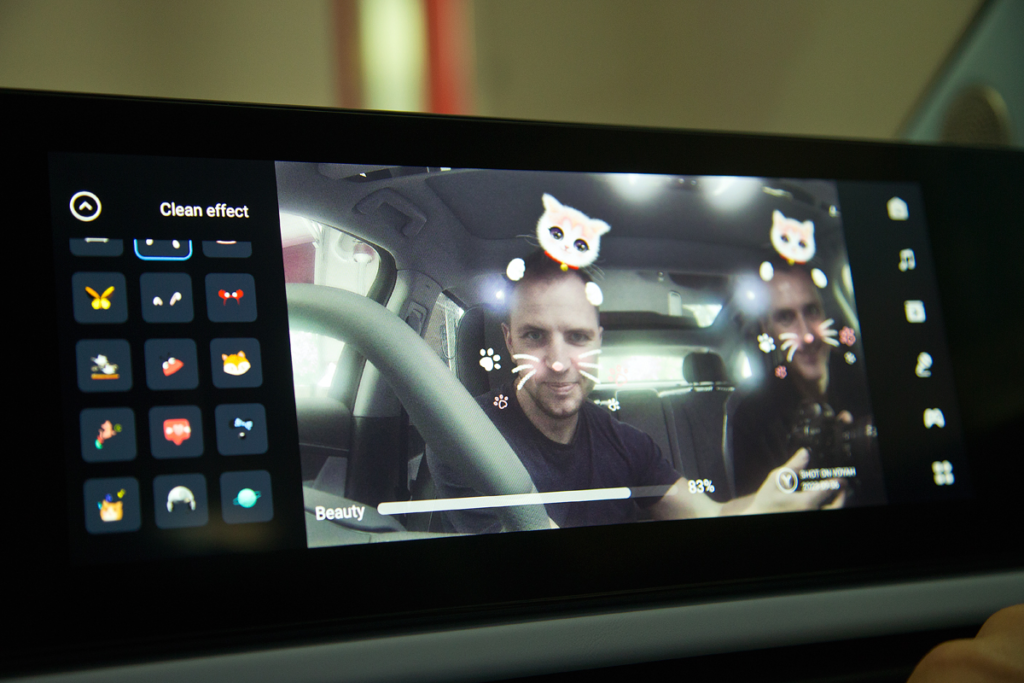
The interior cameras allow you to record videos with overlaid animations.
For kids, the most enjoyment comes from the interactive camera mode – you can record a video with funny animations overlaid on your face. Whether it’s with soap bubbles on your head, ears, or amusing cat faces… It might feel like a kindergarten, but it lifts the spirits even for those over 40.
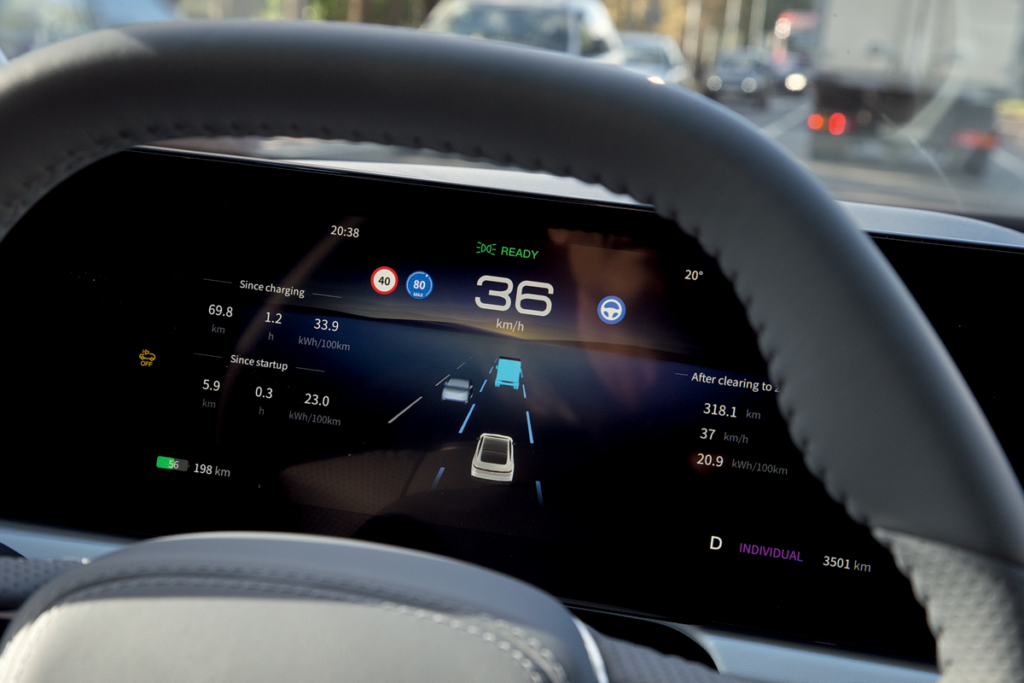
Strangely, Passion offers only one dashboard design.

On the projection display, there are large symbols. Unfortunately, the augmented reality navigation mode doesn’t work in Russia.
However, it’s important to note that these distractions can pose a safety hazard while driving. While they amuse passengers, they can divert the driver’s attention from the road. Fortunately, the Voyah Passion comes equipped with a comprehensive set of electronic driver-assist features, including lane-keeping assistance, automatic braking, and active cruise control. The active cruise control, in particular, functions quite effectively. However, it lacks a speed limiter mode.
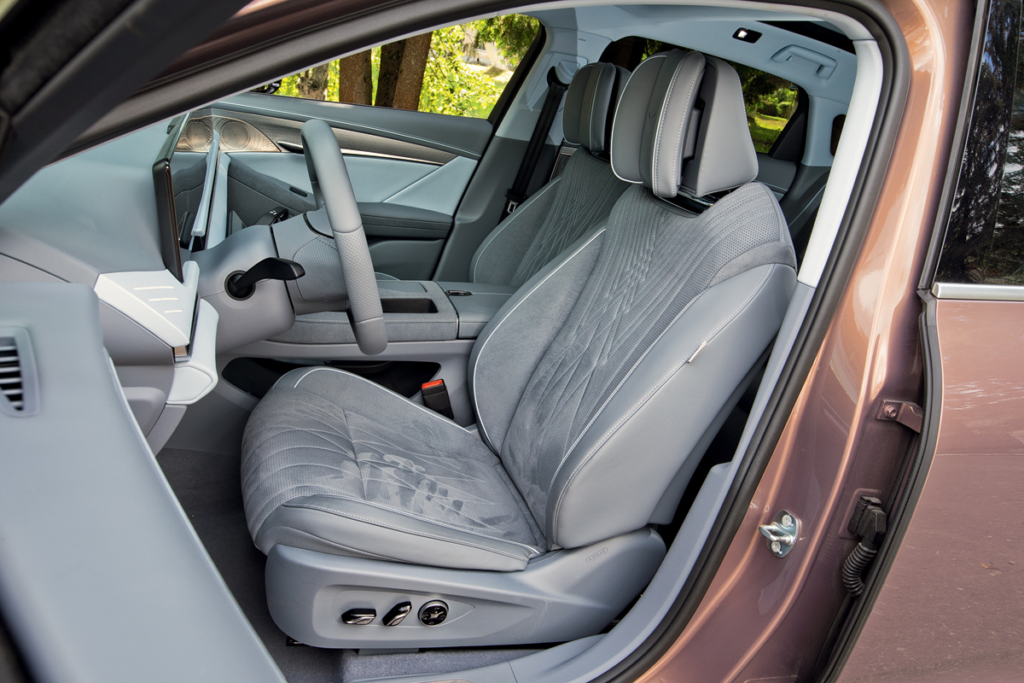
The cushion is a bit short, but the seat is equipped with not only heating and ventilation but also a power massager.

You can save settings for driving, relaxation, and something else on the driver’s seat.
Instead, there’s a road sign scanner that displays speed limits, no parking/stopping signs, and even roadblock warnings. If these notifications become overwhelming, you can easily disable this function through the menu. Voyah allows for flexibility in this regard. For example, the somewhat intrusive pedestrian deterrent sound synthesizer at low speeds can also be turned off, as can the automatic transmission from the side camera when turning. You have the freedom to customize your preferences, but it’s advisable to consider the entire package when purchasing the car.

The second row is spacious; the seatbacks can be adjusted in angle with electric drives. There’s also a footrest on the right, but it can only be fully utilized by passengers of average height.

In the fold-down armrest on the rear sofa, there’s another tablet with climate control settings – including heating, ventilation, and massage! And don’t be put off by the hieroglyphs – everything is already in English on commercial vehicles.
When you invest in a Voyah Passion, you’re primarily paying for its striking design and cutting-edge electric technology. Under the hood, you’ll find two synchronous electric motors with permanent magnets, boasting a combined power output of 510 hp and a robust 730 Nm of torque. To put that into perspective, it surpasses the torque figures of a gasoline V12 engine in a Ferrari 812 (which offers “only” 718 Nm). The Voyah Passion boasts all-wheel drive, near-perfect weight distribution, and adaptive air suspension. Our test sedan is equipped with an 82.1 kWh base battery, providing an official range of 483 km on the European WLTP cycle.

Through the menu you can set different scenarios for the operation of the rear spoiler. For example, it can rise in welcome mode when the car is unlocked
As my colleague Andrey Mokhov sets up our measuring equipment on the car, I delve into the settings menu. To my surprise, you can configure the speed at which the rear spoiler raises and lowers. According to the manufacturer, this spoiler generates an additional 40 kg of downforce on the rear wheels. However, for optimal acceleration, some drivers may prefer to leave the spoiler deactivated. I set it to “Off” and roll onto the dynamometer track at the proving ground. With each acceleration run, the Voyah Passion consistently reaches 100 km/h in 4.2 to 4.3 seconds, without the need for launch controls or two-pedal starts. A mere 14 seconds later, the speedometer displays 200 km/h. The acceleration is truly impressive! However, it doesn’t last for long. The electronic limiter steps in, capping the speed at 208 km/h on the speedometer. While this is a significant achievement, it doesn’t quite match the Tesla Model 3 Performance, which can reach speeds of up to 260 km/h (AR #15-16, 2022).

*Acceleration in sport mode
| Parameters | Electric Car Voyah Passion |
|---|---|
| Maximum Speed, km/h | 207.5 |
| Acceleration Time, s 0—50 km/h 0—100 km/h 0—150 km/h 0—200 km/h 400 m Sprint (s) 1000 m Sprint (s) 60—100 km/h 80—120 km/h | 2 4,2/5,7* 8,1 14,2 12,4 23 2,0* 2,5* |
| Run Down 50 km/h 130—80 km/h 160—80 km/h | 856 1583 2415 |
| Braking Distance From 100 km/h Path, m Deceleration, m/s² From 150 km/h Path, m Deceleration, m/s² | 37,1 10,4 84,9 10,2 |
*Acceleration in Sport/Comfort mode
It’s intriguing to observe that the instantaneous readings on the electronic wattmeter during acceleration reach an impressive 390 kW, equivalent to a potent 530 horsepower. This exceeds the rated power by 15 kW! However, transitioning the driving electronics from Sport mode to Comfort (achieved by touching one of the sensors adjacent to the selector knob) noticeably dampens the car’s performance. In Comfort mode, the Voyah Passion takes a minimum of 5.7 seconds to reach 100 km/h. As indicated by the wattmeter, the electronics restrict power to 310 kW (422 hp) in this mode.
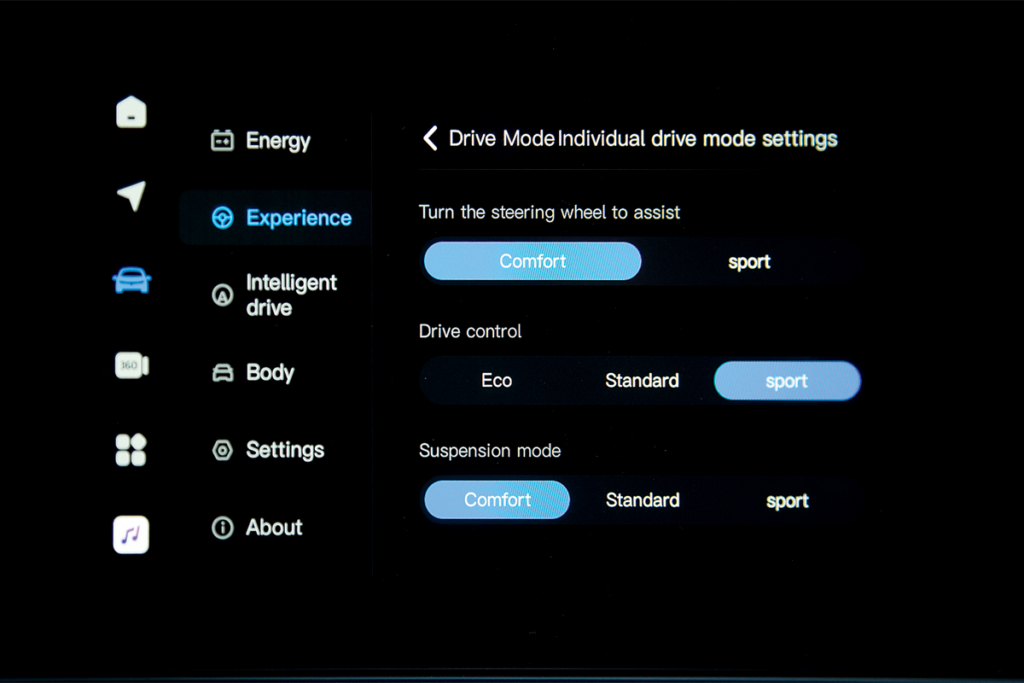
The Individual mode presents a valuable feature, allowing you to select maximum power delivery from the powertrain while retaining comfortable suspension settings.
In Eco mode, a modest 210 kW (286 hp) is available, regardless of how assertively you press the accelerator. This limitation is somewhat peculiar, as conventional vehicles typically allow full engine power when using the kick-down function, irrespective of the selected mode. Even electric cars typically limit power only in cases of critically low battery charge. In contrast, our Voyah Passion still boasts an 80% battery charge. Therefore, to dazzle passengers or fellow motorists with rocket-like acceleration, Sport mode must be activated. In this mode, both suspension and steering tighten up, though this may be less comfortable. Fortunately, the Individual mode provides an ideal solution. Here, you can configure the powertrain to Sport while shifting the suspension and steering to Comfort settings—a perfect balance.

The sedan boasts an array of 12 cameras, with 10 positioned on the exterior. The company promises customers an online update for the autopilot, which currently operates solely as adaptive cruise control.
Regardless of its state, the Voyah Passion precisely follows the accelerator pedal, responding promptly without delay. Managing speed within traffic is a pleasure, as is deceleration. After testing all three recuperation modes, I noticed no roughness. There were no issues with braking efficiency or thermal stability either. Post-testing, there was merely a faint odor of brake pads—no smoke, a common occurrence during tests of Korean or Japanese cars. It’s clear that ventilated discs are installed not only at the front but also at the rear, featuring two-piston calipers up front.
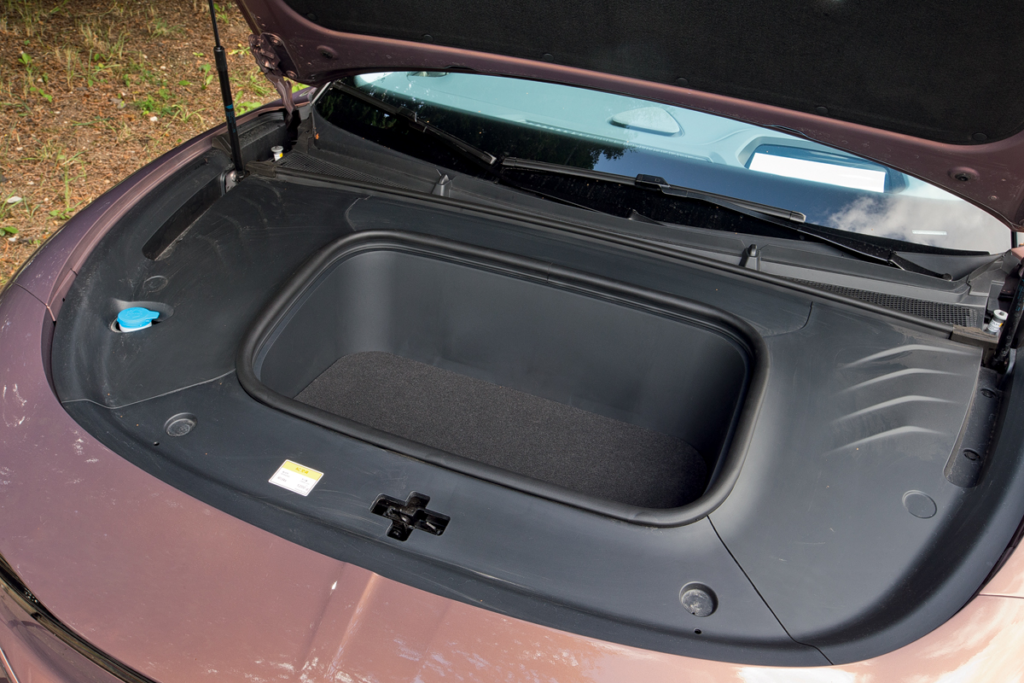
A handy additional storage compartment up front allows for convenient storage of charging cables. The lid is equipped with gas struts for ease of use.
The platform on which the Passion sedan is built is the same modular ESSA (Electric Smart Secure Architecture) found in the Free and Dreamer models. This platform boasts pneumatic suspension and adaptive shock absorbers that adjust stiffness in real-time, based on the road image captured by a camera located under the windshield. This dynamic suspension system performs impressively, smoothly navigating rough asphalt and speed bumps. However, when encountering more significant bumps, the suspension exhibits some limitations, and the shock absorbers work near their capacity. This behavior is expected, as no pneumatic system can fully compensate for low-profile tires. The Passion employs 245/45 R20-sized tires, specifically European Continental EcoContact 6, albeit manufactured in China.

The rear trunk lid has electric drive, but it can only be activated from the key or the display on the front panel; there’s no external button.

In the underfloor area, there’s a repair kit with sealant instead of a spare tire.
Nonetheless, the adjustable suspension remains a valuable feature. For instance, if you dislike body roll while driving in Comfort mode at high speeds, you can select presets such as Standard or Sport. In Sport mode, the Voyah Passion confidently handles turns, adhering firmly to the road, responding accurately to steering inputs without excessive sharpness. Furthermore, the rear axle assists in maintaining traction during changing conditions, delivering a pleasant sensation of being securely “screwed” into the turn when lifting off the throttle. Under acceleration, the tires manage to emit a slight squeal just before the stability control system intervenes. While it is possible to deactivate this system, it is only allowed at speeds of up to 80 km/h. A more naturally weighted steering would be an excellent addition for track use. However, the Voyah Passion remains a heavyweight, tipping the scales at almost 2.3 tons even in its fully equipped state.
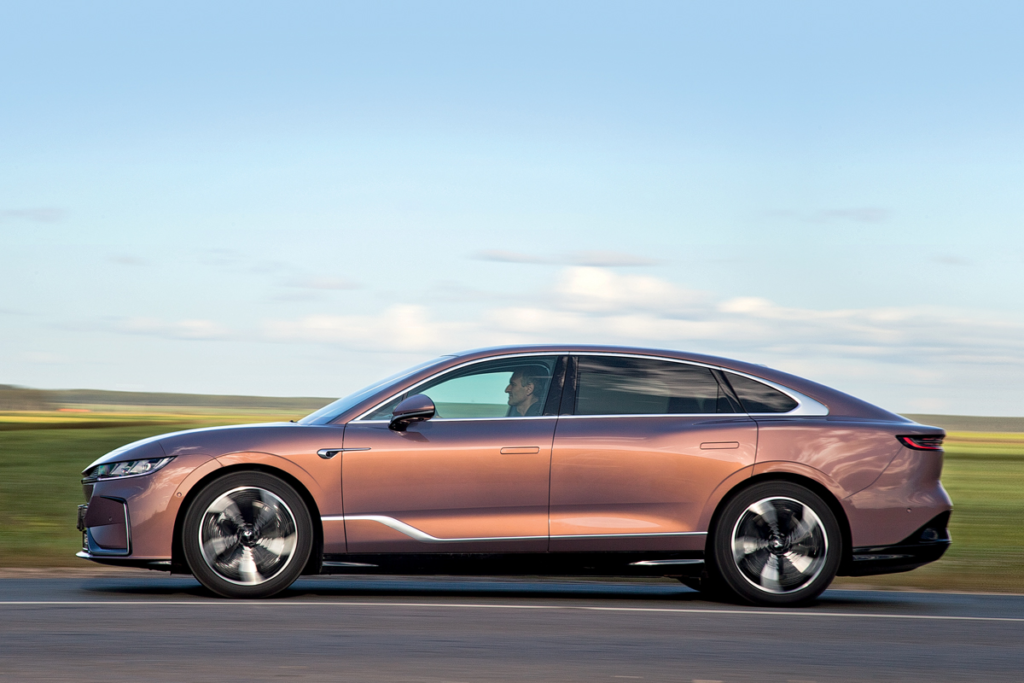
In Sport mode, the body is lowered by 16 mm; when driving on a bad road, it can be raised by 56 mm, but only at speeds up to 40 km/h
For everyday active driving, the car proves highly suitable, partly due to the efficient energy recuperation during braking. This efficiency is evident in the impressive range figures. In urban settings, real-world ranges of 350-380 km are easily attainable, with an average energy consumption of approximately 21 kWh/100 km. Crucially, ensure that you switch the remaining range counter from theoretical mode (based on the Chinese CLTC cycle) to practical mode. In the former, the Voyah Passion boasts an astounding range of 580 km on a full battery!
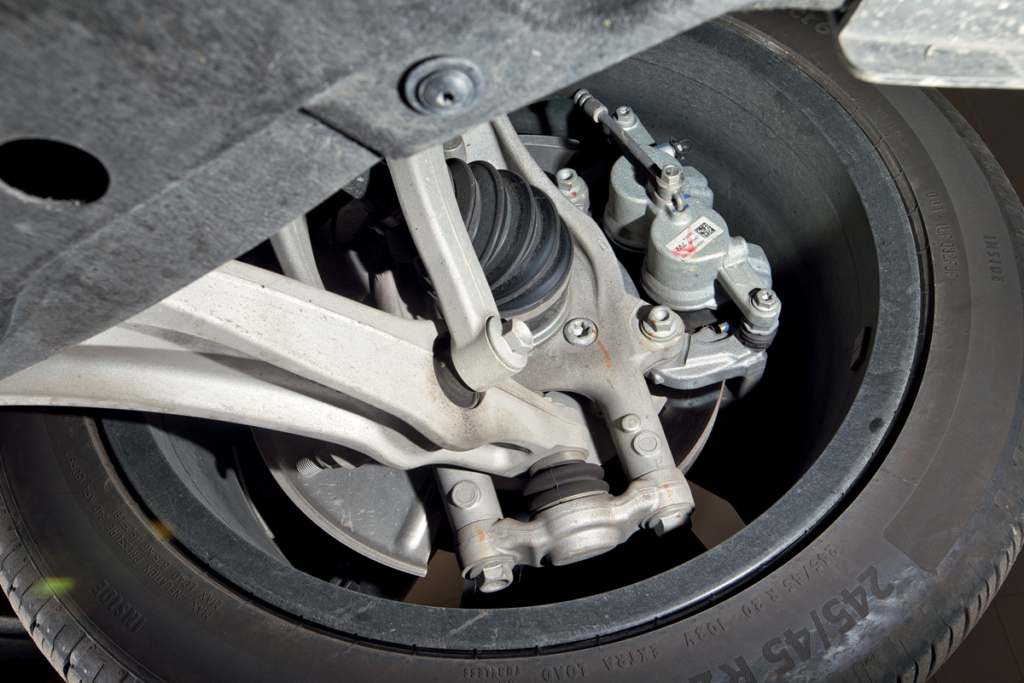
The front double wishbone suspension is entirely aluminum, with a two-point ball joint mount.

In the rear, there’s a multi-link suspension with intricate stabilizer bar mounts.
Regarding charging, the process is relatively standard. For rapid charging, search for a terminal equipped with the Chinese “GB/T pistol.” At the Dmitrovsky test track, such a terminal was available, and the Passion charged from 20% to 100% in approximately one and a half hours, with charging power peaking at 60 kW. We also tested alternating current charging at the free “Energiya Moskvy” terminals, which functioned seamlessly. This method utilizes all three phases, with the onboard converter rated at 11 kW.

In conclusion, charge up and enjoy the ride! The Voyah Passion has a somewhat unique flavor, akin to passion fruit. Interestingly, the name of this fruit with its delightful pulp and occasionally inconvenient seeds also draws inspiration from the word “passion”. In the Voyah Passion electric car, the overall pleasant experience is only slightly marred by a few “seeds” in the form of the angular steering wheel and the abundance of sensors. However, the primary consideration remains its price. The test model, priced at eight and a half million rubles, is not the pinnacle. In Russia, the Voyah Passion Long Range variant is also available, featuring a larger 108.7 kWh battery and an advertised range of 608 km according to the WLTP cycle. In practice, you can expect a range of 450-500 km on a single charge. However, the Long Range model commands a higher price tag of 9.8 million rubles. The pricing for the hybrid Voyah Passion is yet to be determined, even in China, where the sales launch is still anticipated. We eagerly await this information, as statistics indicate that three quarters of the Voyah brand cars sold here are hybrids.

The protrusion above the rear window is the full-width strip of the third brake light

Manufacturers’ data are highlighted in blue/Autoreview measurements are highlighted in black. Dimensions are in millimeters.
*Actual vehicle weight without driver, with full fuel tank and full process fluids
**For right rear seat
**Interior width at shoulder level in the first/second row of seats.
| Electric Car Information | Voyah Passion |
|---|---|
| Body Type | Four-door Sedan |
| Seating Capacity | 5 |
| Curb Weight, kg | 2266 |
| Gross Weight, kg | 2641 |
| Front Trunk/ Rear Trunk Volume, liters | 53/410 |
| Coefficient of Aerodynamic Resistance (Cx)⠀ | 0.225 |
| Front Traction Electric Motor Type Location Max Power, hp/kW Max Torque, Nm | Synchronous, Permanent Magnets Transverse, Above the Front Axle 217.5/160 310 |
| Rear Traction Electric Motor Type Location Max Power, hp/kW Max Torque, Nm | Synchronous, Permanent Magnets Transverse, Above the Rear Axle 292.5/215 420 |
| Combined Electric Motors Power, hp/kW | 510/375 |
| Combined Torque, Nm | 730 |
| Traction Battery Type Location Battery Capacity, kWh Operating Voltage, V | Semi-Solid, Lithium-Ion Under the Cabin Floor 82.1 400 |
| Drivetrain | All-Wheel Drive |
| Front Suspension | Independent, Pneumatic, Double Wishbone |
| Rear Suspension | Independent, Pneumatic, Multi-Link |
| Front Brakes | Ventilated Discs |
| Rear Brakes | Ventilated Discs |
| Tire Size | 245/45 R20 |
| Max Speed, km/h* | 210* |
| 0-100 km/h Acceleration Time, s | 3.8 |
| WLTP Cycle Range, km | 483 |
| Time for Slow AC Charging 20-80%, hours | 5.2 |
| Time for Fast DC Charging 30-80%, minutes⠀ | 27 |
*Electronic Limited Speed
Photo: Dmitry Pitersky
This is a translation. You can read an original article here: Страсть и маракуйя: смакуем Voyah Passion на полигоне

Published December 13, 2023 • 15m to read

